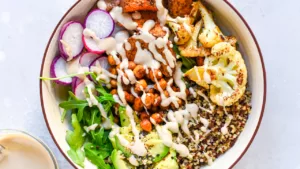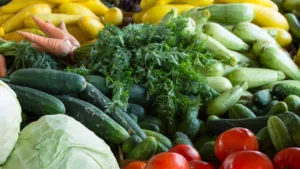In this article, we will cover over 100 plus words to describe food. In the world of vegan cuisine, describing flavors is key for a blogger like me. The taste of your plant-based dishes grabs readers’ attention and keeps them coming back. Crafting descriptive and enticing language in your recipes is vital to create anticipation and may even encourage hesitant eaters to try something new.
Whether you’re a food blogger, restaurant owner, or home cook, using mouth-watering adjectives is crucial. The right words can make your food irresistible, stirring emotions in your readers or customers. Apart from the mentioned adjectives, there are many others like succulent, savory, luscious, tangy, zesty, juicy, tender, and more that vividly describe the appearance of food.
Choose adjectives that accurately portray your food’s flavor, texture, and appearance, appealing to your target audience. By selecting the right words, you can make your audience crave your food even before they taste it. This is is especially great if you put out food blog posts or for food bloggers. It can help your readers visualize the taste of food.
Words To Describe Food Taste
Here are some commonly used words that vegans often use to describe plant-based cuisine.
| Flavor | Description |
|---|---|
| Acidic | A sharp, tart, or sour taste. |
| Bitter | A sharp and sometimes harsh taste. |
| Bittersweet | A taste that couples tartness with sweetness. |
| Briny | Another word for salty. |
| Citrusy | A bright flavor like that of lemons, limes, oranges, and other citrus fruits. |
| Cooling | A taste that mimics the feeling of cold temperature is often used to describe mint. |
| Earthy | Reminiscent of fresh soil, often used to describe red wines, root vegetables, and mushrooms. |
| Fiery | A taste that feels as though it gives off heat, another word for spicy. |
| Fresh | A light and crisp taste is often used to describe produce or herbs. |
| Fruity | Any taste reminiscent of sweet fruit flavors. |
| Full-bodied | A rich flavor that can feel heavy in the mouth, often used to describe wines. |
| Herbal | A bright, fresh, or sometimes earthy taste created by the incorporation of herbs. |
| Honeyed | A sweet or candied taste that may be reminiscent of honey. |
| Nutty | Any taste similar to the flavors of nuts, often used to describe cheeses. |
| Rich | A full, heavy flavor, often used to describe foods containing cream. |
| Robust | A rich taste with some earthiness, often used to describe wines or aged liquors. |
| Sharp | A harsh, bitter, or tart taste, often used to describe acidic foods. |
| Smoky | A smoky taste reminiscent of the smell of smoke. |
| Sour | A biting, tangy, tart flavor. |
| Spicy | A burning taste from hot spices. |
| Sweet | A sugary flavor. |
| Tangy | A tart, biting taste that feels tingly in the mouth. |
| Tart | A sharp, bitter, or sour flavor, often used to describe acidic foods. |
| Yeasty | An earthy taste reminiscent of yeast, often used to describe beer and breads. |
| Woody | An earthy, sometimes nutty taste, often used to describe coffees or cheeses. |
| Zesty | A fresh, vivid, or invigorating flavor. |
Words to Describe Food Texture
Describing the mouthfeel of your dish can help your readers imagine what it will be like to eat before they try it out. So, here are some commonly used words to describe texture that you can use in your next recipe.
| Texture | Description |
|---|---|
| Airy | A light, pillowy texture often created by the incorporation of air. |
| Buttery | A smooth and creamy texture similar to that of butter. |
| Chewy | The texture of a food that needs to be chewed thoroughly before swallowing. Can be light and bouncy or heavy and sticky. |
| Creamy | A smooth and rich texture that usually comes from the incorporation of plant-based dairy. |
| Crispy | A light texture with a slight crunch. |
| Crumbly | The texture of a food with a loose structure that falls apart into small pieces or crumbs. |
| Crunchy | A firm, crisp texture often identified by the sharp, audible noise that the food makes when being eaten. |
| Crusty | The texture of a food with a hard outer layer and soft interior. |
| Delicate | A light, fine texture that may come apart easily. |
| Doughy | A soft and heavy texture that is often coupled with pale coloring. |
| Fizzy | A texture brought on by the presence of many small bubbles, usually referring to carbonated liquids. |
| Flaky | A light texture characterized by layers that come apart during eating. |
| Fluffy | A light and airy texture. |
| Gooey | A viscous, sometimes sticky texture arising from the presence of moisture in a dense solid food. |
| Hearty | A firm, robust texture. |
| Juicy | A succulent, tender texture characterized by the presence of liquid in a solid food. |
| Silky | A fine, smooth texture characterized by a sleek feel in the mouth. |
| Sticky | A texture characterized by gluiness in the mouth. |
| Smooth | A consistent texture free of grit, lumps, or indentations. |
| Succulent | A tender, juicy texture. |
| Tender | A soft texture that is easy to break down. |
| Velvety | A smooth and rich texture. |
Words to Describe Food Preparation Method
This section gives your readers a better understanding of the flavors and textures they can expect. Here are some words to describe food preparation methods.
| Word | Description |
|---|---|
| Baked | Cooked in an oven resulting in a crispy outer layer |
| Blanched | Scalded in boiling water then moved to cold water to stop cooking resulting in a softened texture |
| Blackened | Coated with spices and cooked in a hot pan resulting in a blackened appearance |
| Braised | Briefly fried then slowly stewed resulting in a seared, crispy exterior with a tender interior texture |
| Blitz | Quickly blend or puree food in a food processor or blended |
| Breaded | Coated with a breadcrumb mixture or batter then baked or fried into a crispy outer layer |
| Broiled | Cooked with intense radiant heat resulting in a darkened appearance and crispy texture |
| Caramelized | Cooked slowly until browned and becomes sweeter in taste |
| Charred | Grilled, roasted, or broiled resulting in a blackened exterior coupled with a smoky flavor |
| Fermented | Introduced to bacteria, yeast, or another microorganism to produce organic acids, alcohols, or gases resulting in a pungent, biting flavor |
| Fried | Cooked by submerging partially or fully into hot oil resulting in a crispy or crunchy texture and golden color |
| Glazed | Moistened by having a flavorful coating dripped or brushed onto its surface resulting in a glossy appearance and thin, crisp outer layer |
| Infused | Steeped in liquid with another ingredient in order to extract the flavor of the ingredient often used with herbs |
| Marinated | Soaked in liquid containing flavorful ingredients like herbs, spices, vinegar, and oil |
| Poached | Cooked in nearly boiling liquid resulting in a tender, moist texture |
| Roasted | Cooked with dry heat in an oven or over a fire resulting in a browned exterior and crisp coating |
| Sauteed | Cooked quickly in a small amount of fat |
| Seared | Cooked in a small amount of fat until caramelized and then finished by roasting, grilling, or another method resulting in a crisp outer texture and tender interior |
| Spongy | Soft and springy texture that bounces back when pressed |
| Smoked | Cooked or preserved by long exposure to smoke from smoldering wood resulting in a distinctive, bold flavor |
| Whipped | Beaten to incorporate air resulting in a light, fluffy texture |

Positive Food Adjectives
When describing your vegan recipe or menu items, it’s important to use positive adjectives that create a mouthwatering image in your customers’ minds. Avoid using negative words that may turn off your customers. Positive alternatives to negative words are often more specific, giving your customers a better understanding of what they can expect from your food.
Elevating dining experiences to the next level involves tantalizing taste buds with a symphony of flavors, using words like “exquisite,” “savory,” and “succulent” to paint a vivid picture of each dish.
Negative Adjectives and Their Alternatives
While it’s important to use positive adjectives in your restaurant menu description, knowing how to convey a dish’s limitations honestly with negative meaning is essential. Words like “dry,” “greasy,” or “mushy” carry a negative connotation, but you can also use more nuanced language like “chewy,” “tender,” or “velvety” to soften the critique. For instance, instead of saying a dish has a “hard texture,” you might describe it as “crispy,” creating a more inviting food blog post. This helps with a more positive connotation.
Negative and Positive Adjectives Words To Describe Food
| Negative Adjective | Positive Adjectives to Describe Food |
|---|---|
| Dry | Crispy |
| Greasy | Velvety |
| Sugary | Honeyed |
| Burned | Blackened |
| Tough | Hearty |
| Mushy | Tender |
What Are Some Positive Adjectives To Describe Food?
Positive adjectives elevate the allure of food, enticing your audience to savor the experience. Popular choices like delicious, mouthwatering, flavorful, succulent, rich, luscious, and delectable enhance the appeal, making your food stand out and captivating people’s senses.
Key Vocabulary for Describing Food
When crafting menu descriptions or writing your food blog post, it’s important to have a well-rounded culinary vocabulary. Here are some common terms you should keep in mind:
- Savory foods: Foods that have a rich, non-sweet flavor, like roasted vegetables or grilled meats.
- Sweet taste: Desserts like ice cream or chocolate cake often carry this characteristic.
- Greasy food: Items like fried chicken can often be described this way.
- Spicy food: Anything that delivers heat, like chili peppers.
- Sour foods: Think of dishes with lemon or vinegar, often used to add brightness.
What Are Some Negative Adjectives To Describe Food?
While positive adjectives enhance the appeal of your food, negative adjectives can be useful to communicate what your food is not. Common negative adjectives to describe food include burnt, bland, dry, greasy, salty, sour, and tough. Incorporating negative adjectives demonstrates honesty about your food and reflects your commitment to customer experience.

How Do I Choose The Right Adjectives To Describe My Food?
Choosing the right adjectives to describe your food can be challenging, but there are a few things you can do to make it easier. First, consider your audience and what adjectives are likely to appeal to them. Second, think about the specific qualities of your food that you want to highlight, such as its taste, texture, or appearance. Finally, experiment with different adjectives and see which ones work best for your food and your audience.
Conclusion: Words To Describe Food
Food writing is about more than just listing ingredients; it’s about bringing your dishes to life through words. Use these english vocabulary tips to enhance your menu descriptions and captivate your audience with every post. Food enthusiast love to look at a mouth-watering menu description and using these words to describe your dishes is the best way to help explain the texture of food.
Whether you’re describing a rich, juicy food or a crunchy vegetable, taking the time to find the right descriptive words will ensure your readers keep coming back for more.We hope this article has helped enhance your food vocabulary and assists you in crafting some enticing descriptions.




